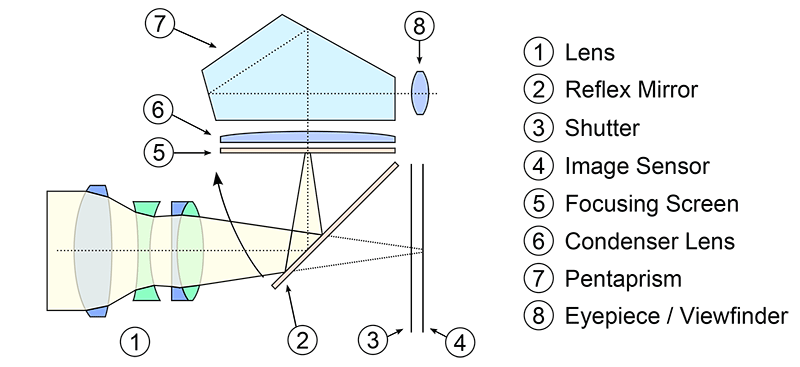Both SLR and DSLR cameras make use of single-lens reflex technology, which utilizes an internal Reflex Mirror that allows the user to see what the lens sees and will be captured through the camera’s optical viewfinder. However, DSLR's have a slight advantage. Some DSLR models offer live digital viewing through the rear LCD screen, just like today’s mirrorless camera without optical viewfinders do.
What DSLR Cameras Consist Of
Take a look at the following image of an DSLR cross section.

How DSLR Cameras Work
When you look through a DSLR viewfinder / eyepiece on the back of the camera, whatever you see is passed through the lens attached to the camera, which means that you could be looking at exactly what you are going to capture.
When you take a picture, the reflex mirror swings upwards, blocking the vertical pathway and letting the light directly through. Then, the shutter opens up and the light reaches the image sensor . The shutter remains open for as long as needed for the image sensor to record the image, then the shutter closes and the reflex mirror drops back to the 45 degree angle to continue redirecting the light into the viewfinder.
1. Lens
The lens is one of the most vital parts of a camera. The light enters through the lens, and this is where the photo process begins. Lenses can be either fixed permanently to the body or interchangeable. They can also vary in focal length, aperture, and other details.
2. Viewfinder
The viewfinder is the area on the camera that you look through in order to compose your shot. For some cameras, an LCD screen is used as a viewfinder, or your camera may have the option to use either one. Once your photo is taken, it may not look exactly like what you see through the viewfinder. Factors such as lighting, lens, camera settings and your camera’s capabilities will affect the finished result. Because of this, the viewfinder is not intended as a preview of your photo, but rather a tool to aid you in taking it. You, as the photographer, determine the final result.
Most cameras today have a variety of functions and automatic features. The mode dial allows you to select different options, such as automatic mode, program mode, sport mode or macro mode. Older cameras may not have a mode dial, because all of the settings are manual. There are also some compact cameras that use a touch-screen for selecting options instead of a dial.
4. Body
The body is the main portion of the camera, and bodies can be a number of different shapes and sizes. DSLRs tend to be larger bodied and a bit heavier, while there are other consumer cameras that are a conveniently smaller size and even able to fit into a pocket.
5. Shutter Release

6. Aperture
The aperture affects the image’s exposure by changing the diameter of the lens opening, which controls the amount of light reaching the image sensor. Some digital compacts will have a fixed aperture lens, but most of today’s compact cameras have at least a small aperture range. This range will be expressed in f/stops. For DSLRs, the lens will vary on f/stop limits, but it is usually easily defined by reading the side of the lens. There will be a set of numbers stating the f/stop or f/stop range, ex: f/2.8 or f/3.5-5.6. This will be your lowest settings available with that lens.
7. Image Sensor
The image sensor converts the optical image to an electronic signal, which is then sent to your memory card. There are two main types of image sensors that are used in most digital cameras: CMOS and CCD. Both forms of the sensor accomplish the same task, but each has a different method of performance.
8. LCD Screen
The LCD screen is found on the back of the body and can vary in size. On digital compact cameras, the LCD has typically begun to replace the viewfinder completely. On DSLRs, the LCD is mainly for viewing photos after shooting, but some cameras do have a “live mode” as well.


💯 🔥
ReplyDeleteAwesome details... I liked it❤️
ReplyDelete❤️❤️❤️❤️
ReplyDelete